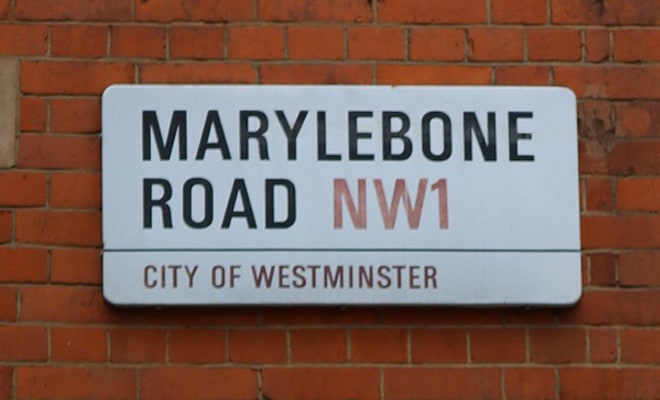Looking for things to do in Marylebone London that go beyond the usual shops and restaurants? This charming central London neighbourhood is packed with hidden history, quirky stories, and cultural gems. From infamous churches to one of the city’s most brutal execution sites, Marylebone history is anything but ordinary.
Whether you’re exploring the best things to do in Marylebone this weekend or just curious about what Marylebone is famous for, here are seven surprising facts that bring the area’s past to life — and give you some great ideas for free things to do in Marylebone while you’re here.
1. Marylebone Had Four Churches — and the First Was Lost to Bandits
Long before the grand porticoed church that stands at the top of Marylebone Road today, the area’s original parish was a far more modest affair. The first church — St John the Evangelist — was built in the 12th century to serve a tiny rural community of just 50 people. Isolated and poorly defended, it didn’t stand much chance against the highwaymen and bandits who regularly passed through. By the late 1300s, it had been dismantled almost entirely.
Two more churches followed. The second, built in the 15th century and tucked further from the road in an attempt to avoid the same fate, gained a notorious reputation for turning a blind eye to unconventional unions — including the scandalous marriage of 45-year-old philosopher Francis Bacon to 13-year-old Alice Barnham. The third, completed in 1742, had a more respectable legacy, baptising both Lord Byron and Horatia Nelson (the daughter of Lord Nelson and Lady Hamilton).
If you’re curious about Marylebone theatre history, literary figures, or ecclesiastical design, the current St Marylebone Parish Church offers all three. Exploring the church and its grounds is one of the more contemplative yet fun things to do in Marylebone, especially for lovers of London’s layered religious past.
2. Marylebone’s Past as a Royal Hunting Ground
Long before townhouses and boutiques lined its streets, Marylebone was a quiet expanse of fields and forest — a rural escape favoured by Tudor monarchs. In the 16th century, the area was enclosed as Marylebone Park, a royal hunting ground used by Henry VIII and later monarchs, stretching from present-day Oxford Street to Regent’s Canal.
At its heart stood Marylebone Manor, a country house near what is now Stratford Place. Though the manor and park have long disappeared, their legacy remains woven into the layout of local streets and nearby green spaces. Regent’s Park itself was developed in the early 19th century from this same royal estate, transforming the former hunting land into one of London’s most beloved public parks.
Strolling through the area today, it’s hard to imagine deer once roamed here — but a keen eye will spot signs of its pastoral past. For those seeking things to do in Marylebone London beyond the usual, tracing the evolution from royal retreat to urban elegance offers a quiet but fascinating look into the history of Marylebone
3. Marylebone Was Once the Site of the Tyburn Tree
Among the more unsettling parts of Marylebone history is its connection to one of London’s most infamous execution sites: the Tyburn Tree. Built in 1571, these enormous triangular gallows were capable of hanging up to 24 people at once — a chilling reflection of the harsh justice system of the time. The condemned could be sentenced for everything from theft and forgery to religious dissent, with many executions drawing large crowds in a kind of macabre public spectacle.
The tree stood at what is now Marble Arch, marking the western edge of what was once the village of Tyburn — a name eventually replaced by Marylebone as the community sought to distance itself from its grisly reputation.
Today, the original gallows are long gone, but a discreet plaque near Marble Arch commemorates the site. While certainly not one of the more cheerful stops, it’s a significant part of the history of Marylebone and offers a fascinating glimpse into London’s darker past. For those interested in unusual landmarks or hidden stories, it’s one of the more thought-provoking free things to do in Marylebone — especially if you’re keen to explore the lesser-known layers of the neighbourhood.
4. Marylebone Station Was Never Finished
If you’ve ever wondered about the quieter side of Marylebone station history, it turns out this charming transport hub was never meant to be quite so modest. Opened in 1899 as the southern terminus of the Great Central Railway, Marylebone was the last major mainline station to be built in London — and its arrival was filled with ambition.
Originally planned to include eight platforms and expansive facilities to rival Paddington or Euston, the station was set to become a major gateway to the north. But a combination of financial difficulties and strong local opposition forced the project to scale down. In the end, only four platforms were completed, leaving the station smaller and simpler than its Victorian counterparts.
Today, that unfinished quality is part of its appeal. With its understated red-brick façade and quieter atmosphere, Marylebone Station offers a welcome contrast to the capital’s busier rail terminals. It continues to operate successfully, serving routes to Oxford, Birmingham, and beyond — all from a station that was once almost too ambitious to survive.
Despite its size, it’s full of charm — and a top spot for anyone seeking free things to do in Marylebone without the tourist crowds. You’ll find a slice of London’s transport history — complete with a sense of what might have been.
5. Edwardian Bookshop, Daunt Books Is a Literary Landmark
If you’re exploring things to do in Marylebone High Street, Daunt Books is more than just an independent bookshop — it’s a destination rich in literary heritage and architectural charm.
Located at 84 Marylebone High Street, the building was designed in 1912 for the Francis Edwards bookselling firm and is allegedly the world’s first purpose-built bookshop. Unlike typical converted retail units, this Edwardian space was conceived specifically for bookselling — featuring oak galleries, a dramatic stained-glass window, and a long skylit central room that evokes the quiet elegance of an old-world library.
Taken over by Daunt Books in 1990, the space has retained its historic character while becoming a beloved fixture in London’s literary scene. The shop specialises in travel writing, with books arranged by country — fiction, non-fiction, and guidebooks shelved side by side — inviting readers to explore the world in unexpected ways.
If you’re interested in Marylebone history, Daunt Books offers a rare opportunity to experience a piece of early 20th-century design still used for its original purpose. Whether you’re after free things to do in Marylebone, browsing for inspiration, or simply admiring the architecture, this bookshop is undoubtedly one of the best things to do in Marylebone, London for anyone with a curious mind and love of beautiful spaces.
What It’s Like to Live in Marylebone Today
Marylebone may be known for its elegant townhouses and high-end boutiques, but its appeal goes far beyond luxury. Behind its refined architecture lies a neighbourhood full of culture, community and everyday convenience — from independent cafés and historic bookshops to leafy parks and excellent transport links.
Whether you’re visiting for the weekend or planning a longer stay, Marylebone offers a rare blend of village charm and city living. And if you’re short on space while settling in, our local self storage facility is just around the corner — perfect for decluttering, downsizing or simply making room to enjoy life in central London.




